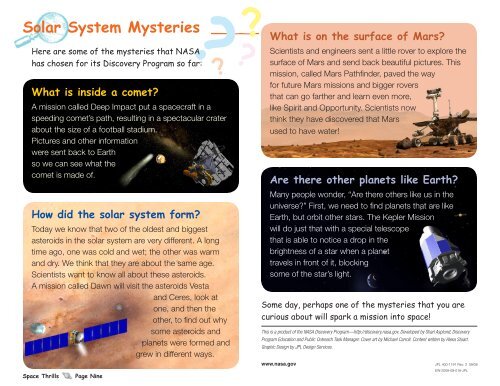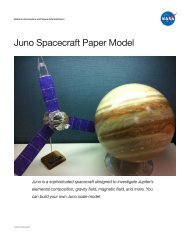meet Our Solar System - New Frontiers - NASA
meet Our Solar System - New Frontiers - NASA
meet Our Solar System - New Frontiers - NASA
You also want an ePaper? Increase the reach of your titles
YUMPU automatically turns print PDFs into web optimized ePapers that Google loves.
Space Thrills Page nine<br />
?<br />
<strong>Solar</strong> <strong>System</strong> mysteries<br />
Here are some of the mysteries that <strong>NASA</strong><br />
has chosen for its Discovery Program so far:<br />
What is inside a comet?<br />
A mission called Deep Impact put a spacecraft in a<br />
speeding comet’s path, resulting in a spectacular crater<br />
about the size of a football stadium.<br />
Pictures and other information<br />
were sent back to Earth<br />
so we can see what the<br />
comet is made of.<br />
how did the solar system form?<br />
Today we know that two of the oldest and biggest<br />
asteroids in the solar system are very different. A long<br />
time ago, one was cold and wet; the other was warm<br />
and dry. We think that they are about the same age.<br />
Scientists want to know all about these asteroids.<br />
A mission called Dawn will visit the asteroids Vesta<br />
and Ceres, look at<br />
one, and then the<br />
other, to find out why<br />
some asteroids and<br />
planets were formed and<br />
grew in different ways.<br />
? ?<br />
?<br />
What is on the surface of mars?<br />
Scientists and engineers sent a little rover to explore the<br />
surface of Mars and send back beautiful pictures. This<br />
mission, called Mars Pathfinder, paved the way<br />
for future Mars missions and bigger rovers<br />
that can go farther and learn even more,<br />
like Spirit and Opportunity. Scientists now<br />
think they have discovered that Mars<br />
used to have water!<br />
are there other planets like earth?<br />
Many people wonder, “Are there others like us in the<br />
universe?” First, we need to find planets that are like<br />
Earth, but orbit other stars. The Kepler Mission<br />
will do just that with a special telescope<br />
that is able to notice a drop in the<br />
brightness of a star when a planet<br />
travels in front of it, blocking<br />
some of the star’s light.<br />
Some day, perhaps one of the mysteries that you are<br />
curious about will spark a mission into space!<br />
This is a product of the <strong>NASA</strong> Discovery Program—http://discovery.nasa.gov. Developed by Shari Asplund, Discovery<br />
Program Education and Public Outreach Task Manager. Cover art by Michael Carroll. Content written by Alexa Stuart.<br />
Graphic Design by JPL Design Services.<br />
www.nasa.gov<br />
JPL 400-1191 Rev. 2 09/08<br />
EW-2008-09-018-JPL



